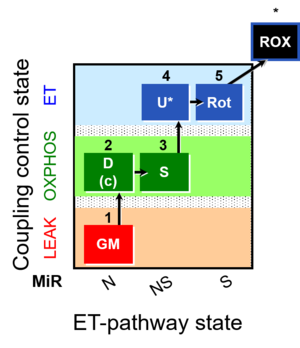Difference between revisions of "Template:SUIT-011"
| Line 2: | Line 2: | ||
{| class="wikitable" border="1" | {| class="wikitable" border="1" | ||
{{Template:SUIT header}} | |||
|- | |- | ||
| Line 23: | Line 18: | ||
| [[N]] | | [[N]] | ||
| CI | | CI | ||
| | | 1GM;2D | ||
{{Template:SUIT N}} {{Template:SUIT OXPHOS}} | {{Template:SUIT N}} {{Template:SUIT OXPHOS}} | ||
| Line 32: | Line 27: | ||
| [[N]] | | [[N]] | ||
| CI | | CI | ||
| | | 1GM;2D;2c | ||
{{Template:SUIT N}} {{Template:SUIT OXPHOS}} {{Template:SUIT c}} | {{Template:SUIT N}} {{Template:SUIT OXPHOS}} {{Template:SUIT c}} | ||
| Line 41: | Line 36: | ||
| [[NS]] | | [[NS]] | ||
| CI&II | | CI&II | ||
| | | 1GM;2D;3S | ||
{{Template:SUIT N}} & {{Template:SUIT S}} {{Template:SUIT NS}} {{Template:SUIT OXPHOS}} | {{Template:SUIT N}} & {{Template:SUIT S}} {{Template:SUIT NS}} {{Template:SUIT OXPHOS}} | ||
| Line 50: | Line 45: | ||
| [[NS]] | | [[NS]] | ||
| CI&II | | CI&II | ||
| | | 1GM;2D;3S;4U | ||
{{Template:SUIT NS}} {{Template:SUIT U*}} | {{Template:SUIT NS}} {{Template:SUIT U*}} | ||
| Line 59: | Line 54: | ||
| [[S]] | | [[S]] | ||
| CII | | CII | ||
| | | 1GM;2D;3S;4U;5Rot | ||
{{Template:SUIT Rot}} {{Template:SUIT ET}} | {{Template:SUIT Rot}} {{Template:SUIT ET}} | ||
| Line 68: | Line 63: | ||
| | | | ||
| | | | ||
| | | {{Template:SUIT Ama}} | ||
{{Template:SUIT Ama}} | |||
|} | |} | ||
{{Template:SUIT CIV}} | {{Template:SUIT CIV}} | ||
Revision as of 17:40, 11 January 2019
| Step | State | Pathway | Q-junction | Comment - Events (E) and Marks (M) |
|---|---|---|---|---|
| 1GM | GML | N | CI | GML or GM_L: Glutamate & malate, N-LEAK respiration, NL
NADH-linked substrates (type N-pathway to Q). Template:SUIT L n |
| 2D | GMP | N | CI | 1GM;2D
NADH-linked substrates (type N-pathway to Q). OXPHOS capacity P (with saturating [ADP]), active OXPHOS state. |
| 2c | GMcP | N | CI | 1GM;2D;2c
NADH-linked substrates (type N-pathway to Q). OXPHOS capacity P (with saturating [ADP]), active OXPHOS state. Addition of cytochrome c yields a test for integrity of the mtOM (cytochrome c control efficiency). Stimulation by added cytochrome c would indicate an injury of the mtOM and limitation of respiration in the preceding state without added c due to loss of cytochrome c. Typically, cytochrome c is added immediately after the earliest ADP-activation step (OXPHOS capacity P with saturating [ADP]). |
| 3S | GMSP | NS | CI&II | 1GM;2D;3S
NADH-linked substrates (type N-pathway to Q). & Succinate, S ( type S-pathway to Q). Respiratory stimulation by simultaneous action of type N substrates & succinate, with convergent electron flow in the NS-pathway for reconstitution of TCA cycle function. OXPHOS capacity P (with saturating [ADP]), active OXPHOS state. |
| 4U | GMSE | NS | CI&II | 1GM;2D;3S;4U
Respiratory stimulation by simultaneous action of type N substrates & succinate, with convergent electron flow in the NS-pathway for reconstitution of TCA cycle function. Uncoupler titration (avoiding inhibition by high uncoupler concentrations) to obtain electron transfer (ET) capacity E (noncoupled ET-state). Test for limitation of OXPHOS capacity P by the phosphorylation system (ANT, ATP synthase, phosphate transporter) relative to ET capacity E in mt-preparations: E-P control efficiency and E-L coupling efficiency. In living cells: E-R control efficiency and E-L coupling efficiency. |
| 5Rot | SE | S | CII | 1GM;2D;3S;4U;5Rot
Succinate pathway control state (S-pathway) after inhibiting CI with rotenone, which also inhibits the F-pathway. Noncoupled electron transfer state, ET state, with ET capacity E. |
| 6Ama | ROX | Rox is the residual oxygen consumption in the ROX state, due to oxidative side reactions, estimated after addition of antimycin A (inhibitor of CIII). Rox is subtracted from oxygen flux as a baseline for all respiratory states, to obtain mitochondrial respiration (mt). |
| Step | Respiratory state | Pathway control | ET-Complex | Comment |
|---|---|---|---|---|
| ## AsTm | AsTmE | CIV | CIV | |
| ## Azd | CHB |
